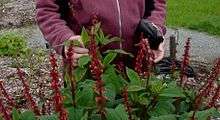Salvia confertiflora
Salvia confertiflora is a herbaceous perennial shrub native to Brazil that will reach 4–6 feet in height and width in one season. It has been used in horticulture in the United States since the 1960s (and earlier in Brazil and France), although it isn't commonly sold at nurseries because of its large size. The dark green leaves, with a yellow undertone, are about 7 inches long by 3.5 inches wide, with serrated edges, and with velvety red-brown hairs on the petiole and stem of the new leaves.
| Salvia confertiflora | |
|---|---|
 | |
| Scientific classification | |
| Kingdom: | Plantae |
| Clade: | Tracheophytes |
| Clade: | Angiosperms |
| Clade: | Eudicots |
| Clade: | Asterids |
| Order: | Lamiales |
| Family: | Lamiaceae |
| Genus: | Salvia |
| Species: | S. confertiflora |
| Binomial name | |
| Salvia confertiflora | |
The inflorescences of S. confertiflora reach up to 2 feet long and are covered with velvety red-brown hairs, with the stems of the inflorescence and the calyx also having a red-brown color. The 0.5 inch flowers are orange-red, and very profuse, explaining the epithet confertiflora, or "crowded with flowers". The plant grows so large that it needs staking and protection from wind in gardens.[1]
Notes
- Clebsch, Betsy; Barner, Carol D. (2003). The New Book of Salvias. Timber Press. p. 86. ISBN 978-0-88192-560-9.
| Wikimedia Commons has media related to Salvia confertiflora. |